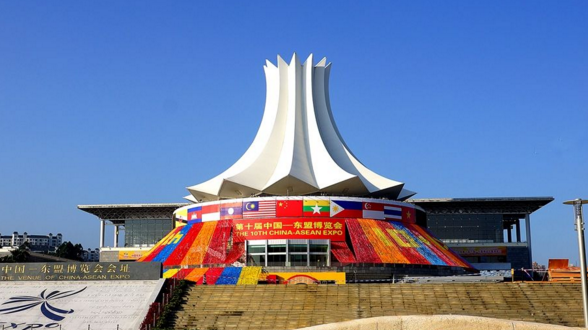BEIJING, May 9 (Xinhua) -- China's economic and trade relation with the Association of Southeast Asian Nations (ASEAN) has become closer in recent years. In the first quarter of this year, ASEAN overtook the European Union to be China's largest trading partner.
With the development of e-commerce, more and more products from China and ASEAN will enter the markets of each other through e-commerce platforms, further driving bilateral trade.
The year of 2020 highlights China-ASEAN cooperation in the field of digital economy. Cooperation in new areas such as artificial intelligence, smart cities, e-commerce and 5G will be expanded.
-- Closer economic and trade ties
The economic and trade exchanges between China and ASEAN in the first quarter of this year were not greatly affected by the COVID-19 epidemic. The bilateral economic relation turned out to be closer, with expanding trade types and scale, according to Tang Zhimin, director of China-ASEAN Studies Center under the Bangkok-based Panyapiwat Institute of Management.
Data from the General Administration of Customs (GAC) of China showed that ASEAN overtook the European Union to be China's largest trading partner in the first three months, with bilateral trade in goods up 6.1 percent year on year to 991.34 billion yuan.
The increase in the trade volume could be partially attributed to the surge in the import and export of integrated circuits between China and ASEAN in the first quarter, which pushed up the overall growth of bilateral trade by 3.3 percentage points, Li Kuiwen, spokesperson of GAC said in a press conference last month.
During the January-March period, China's imports of integrated circuits from ASEAN reached 105.65 billion yuan, showing an increase of 25.8 percent year on year and accounting for 23.4 percent of the total imports from ASEAN. Its exports of integrated circuits to ASEAN stood at 42.75 billion yuan, up 28 percent year on year and accounting for 7.9 percent of the total exports to ASEAN.
The first quarter also witnessed accelerated energy cooperation between the two sides, which promoted the growth of bilateral trade by 1.7 percentage points. Specifically, the increase in China's crude oil imports from and refined oil exports to ASEAN, pushed its trade with ASEAN up by 1.3 percentage points, added Li.
After the outbreak of the epidemic, ASEAN countries have implemented economic stimulus policies concerning finance, taxation, business, labor and human resources. Against this backdrop, China-ASEAN trade is expected to continue growing, said Xu Ningning, executive director of China-ASEAN Business Council.
-- Booming cross-border e-commerce
Internet-backed cross-border e-commerce (CBEC) is becoming a new highlight of China-ASEAN bilateral trade.
China and ASEAN have cooperated closely in the field of CBEC in the fight against the epidemic. In recent months, commodities from ASEAN countries such as Thai fragrant rice and durian, Malaysian white coffee, etc. were best selling products on Chinese e-commerce platforms including Tmall and Kaola.com.
Data from Kaola.com showed that its sales in Thailand increased by 60.8 percent month on month in March when the country entered the state of emergency. The e-commerce platform's sales in Singapore, Malaysia, Vietnam and Philippines also rose significantly.
China's e-commerce giant Alibaba is building an e-commerce and logistics distribution center in the free trade zone of Thailand's Eastern Economic Corridor. Upon completion, the distribution center will greatly promote the cross-border e-commerce trade between China, Thailand and even ASEAN, said an industry insider.
With the development of e-commerce, more and more products from China and ASEAN will enter the market of each other through e-commerce platforms, according to a local magazine of Myanmar.
-- Broad prospects for cooperation
Amid the epidemic, the trade between China and ASEAN has gradually moved up toward high value-added industrial chain, with more cooperation and exchanges in the digital economic areas such as 5G and smart cities. This has injected impetus into the bilateral trade and the prospect of China-ASEAN economic and trade cooperation remains broad, said Tang.
To reduce the impact of the epidemic on the economy and society, leaders from ASEAN, China, Japan and the Republic of Korea (ASEAN Plus Three or APT) agreed in a recent special meeting that they would take measures to maintain the necessary flow of people and logistics, maintain the stability of the regional industrial chain and supply chain, and support the signing of the Regional Comprehensive Economic Partnership (RCEP) at an early date, so as to continuously promote the regional economic integration.
The RCEP, initiated by the Association of Southeast Asian Nations (ASEAN) in 2012, is a proposed free trade agreement (FTA) between the ten member states of the association and the six FTA partners of ASEAN, that is, China, Japan, the Republic of Korea, Australia, New Zealand and India.
The year of 2020 highlights China-ASEAN cooperation in the field of digital economy. Cooperation in new areas such as artificial intelligence, smart cities, e-commerce and 5G will be expanded.
In addition, the 17th China-ASEAN Expo to be held from September 18 to 21 will focus on building the Belt and Road and strengthening digital economy cooperation.
As the Belt and Road construction advances and ASEAN countries' infrastructure improves, the regional industrial chain will be further integrated, propelling the trade between China and ASEAN, stated Zhu Zhaoyi, researcher with the international economic research institute under the University of International Business and Economics. (Edited by Su Dan with Xinhua Silk Road, silviasu07@163.com)




 A single purchase
A single purchase









